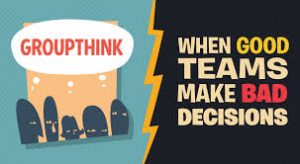Groupthink: the cost of collective stupidity

Years ago I sat next to a lovely young man on a plane. Dressed for success, he exuded professionalism.
SD: You’re all dressed up to see a client, I bet. You look great.
YM: Thanks. I am. I’m going to offer my services free to a prospect for 2 weeks and hope he accepts.
SD: I bet you hope that you’ll prove your worth him paying for your services.
YM: I do! But I don’t know if any of it will pan out.
SD: What’s stopping you from facilitating him and his team through their pre-sales decision making so they all realize they need you and are willing to pay for you?
YM: You sound just like this book I just read on helping buyers buy. It was brilliant, and the author says prospects don’t have problems with our solutions, merely understanding their risk of change. And sellers should lead them through the change process before we push product details. I thought that was smart.
SD: (holding back a smile, as he was of course talking about my book Dirty Little Secrets: why buyers can’t buy and sellers can’t sell): So what’s stopping you now from helping these folks first manage their change so they can identify as buyers before giving them free work?
YM: I told my boss I thought we should bring her in to train us all. I got him a copy of her (my!) book. He read half of it then told me it was crazy stuff, that that isn’t the way to sell, and to not do anything she suggests. So I’m sort of stuck.
This man’s boss would rather risk the cost of his travel, his time, his opportunity cost and the prospect’s goodwill than add new sales skills and have a much greater chance of closing the sale. He wasn’t even curious enough, or respectful enough, to allow the man to try something new.
WE’D RATHER BE STUPID THAN DIFFERENT
Groupthink. A form of structural stupidity. Going along with the status quo because…. because what? Is rigidity acceptable merely because everyone follows the same flawed thinking?
I don’t understand why the risk of change with a credible chance of success is greater than the cost of customary activities when their probability of failure is known to be high.
Failure is such a known quantity in several industries that companies build it into their budgets. They
- build in extra time for a project to manage resistance during change initiatives (95% fail rate);
- continually seek new coaching clients after they cancel when they haven’t gotten the promised results (80%);
- bring in additional training programs because the training provided wasn’t retained (90% fail rate);
- budget training funds for new hires due to attrition, when perfectly good employees leave due to low morale;
- hire 9x more sales folks because of the 95% failure rate due to outdated sales thinking.
And yet they keep doing what they’ve always done, getting the same results. Hello Einstein!
PUSH BACK
As an original thinker and inventor of proven (and innovative) models that correct for, and entirely avoid, these failures in sales (Buying Facilitation®), coaching, training, and change management (Change Facilitation), I’ve been running into this blind spot for decades. And I still can’t understand why people would choose to continue failing when, with a few changes, they could avoid resistance, enable permanent change and learning, and retain good employees.
But no matter how many books (10, including Selling with Integrity, the first sales book on the New York Times Business Bestseller’s list) I’ve written; how many people I’ve spoken to on radio, tv, podcasts, keynotes over forty years; or Fortune 500 clients I’ve successfully trained (many); I still get major pushback: the risk of change is higher than their need for success.
To show you how endemic the resistance to change is, here are some real comments following highly successful Buying Facilitation® pilots that taught sellers how to close sales in one quarter the time, AND with Servant Leader tools:
(Proctor and Gamble): Given the speed of closing and increased sales we’d experience if everyone used Buying Facilitation®, we’d need to speed up manufacturing, hire more support folks, buy more trucks… It would cost $2,000,000,000 and take us 2 years to recoup. We’re not set up for that.
(Boston Scientific): We got a 53% increase in closed sales and the sales folks loved it. Thanks, Sharon-Drew. But the model is too controversial for easy adoption.
(Kaiser Permanente): We pay sellers for numbers of visits and we have no way to pay per closed sales. [Note: their sales went up from 110 visits/18 closed sales to 27 visits/25 closed sales.]
(WmBlair & Co): This is crazy stuff. This isn’t sales. You folks just got lucky (said folks as they watched their colleagues close sales quickly).
I could go on. Thankfully, early adopters have hired me to train sales and consulting departments in many global corporations over the years. But too often my innovative concepts get compared against the standard tools and folks either don’t believe it’s possible to sell from the Buy Side (client success studies and references aside) or can’t get buy-in from their teams to do anything differently. Groupthink prevails.
STAYING THE SAME AT ALL COSTS
The perceived risks of change seem too high for mainstream. But take a look at the risks of following Groupthink:
- You always get what you always got – regardless of what else is possible.
- You use resource (people, money, time) to build strategies and practices around what has a high likelihood of minimal success, low adoption, high cost.
- You assume that the known fail rate – in sales, coaching, OD, change management, consulting, marketing, training – is what ‘is’ and build the failure into a project rather then researching innovative options with a history of success.
In my map of the world, when I see something failing after a fair trial period, I change the thinking behind the problem, not merely move around the chairs. I understand I can’t get it right initially, but failure is nothing but a tap on the shoulder reminding me to do something different. In fact, failure is a necessary element of learning and change. Why has it gotten such a bad rap? And why is it a more potent determinate of action than the possibility of success?
Here are my guesses as to why companies maintain models that demonstrably fail:
- They prefer the known failure as there’s a buy-in for it.
- They don’t know what’s worth taking a risk on (And don’t discuss alternative possibilities with the team).
- They build in or hide the fallout (Sales operations record real costs – outsourced lead gen, for example – in the cost center and closed sales in the profit center) so the success ratio appears larger than it really is.
- They don’t know who or what to trust. (And haven’t done purposeful research to get references or read case studies that prove it.)
- They assume what they’re doing is the best that can be expected. (And don’t question that premise as per egos and job expectations.)
- They don’t know how to strategize using a different model.
- They assume the failure is an accurate version of what’s possible. (And haven’t researched alternate, proven modalities.)
- They assume that since the model is the standard model used in the field, it must be the best option. (And they consider the risk of change higher than the risk of success.)
Yet resistance, non-compliance, failure to close, failure to learn, failure to not permanently adopt new behaviors, is failure they’re maintaining.
At what point is the risk of change worth taking? When is the cost of failure less than the cost of trialing something out-of-the-box? After all, different thinking is the only way real change happens.
WHAT IS YOUR RISK?
Here are some questions to help you consider going outside the box going forward:
- What would you need to know to be willing to consider the prospect of doing something different(ly) even though your colleagues continue their current activity?
- What would you need to know or believe differently to be willing to consider your consistently low success rates ‘failure’ can be turned around by trialing something new?
- How will you know when you haven’t found a fix for a problem (i.e. resistance, low close rates, low learning retention etc.) and the risk of an innovative solution is less than the risk of the status quo?
- What colleagues would you need to include in thought discussions and noodling as you consider the risk of doing something new?
- If you decide you’re willing to discover innovative approaches to consistent problems, how will you know who or what to trust? What would you need to know or understand to be assured that your trust is well placed?
- How will you know that a possible solution is truly innovative? That you can trust the pitch or the hype?
Personally, I don’t consider failure an option. For me, the risk of trialing something new when I know the enormous risks of maintaining the status quo is not a real risk given the alternative. Without innovation, without the risk of disruption in the name of success, continued failure is the only option. If you’re willing to go beyond Groupthink and consider innovative, successful alternatives that have been proven in global corporations, contact me.
___________________________
Sharon-Drew Morgen is a breakthrough innovator and original thinker, having developed new paradigms in sales (inventor Buying Facilitation®, listening/communication (What? Did you really say what I think I heard?), change management (The How of Change™), coaching, and leadership. She is the author of several books, including her new book HOW? Generating new neural circuits for learning, behavior change and decision making, the NYTimes Business Bestseller Selling with Integrity and Dirty Little Secrets: why buyers can’t buy and sellers can’t sell). Sharon-Drew coaches and consults with companies seeking out of the box remedies for congruent, servant-leader-based change in leadership, healthcare, and sales. Her award-winning blog carries original articles with new thinking, weekly. www.sharon-drew.com She can be reached at sharondrew@sharondrewmorgen.com.
Sharon Drew Morgen March 25th, 2024
Posted In: News

